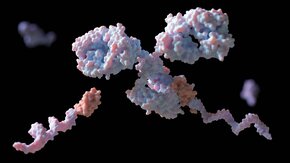Chromatin Immunoprecipitation (ChIP)
Chromatin immunoprecipitation (ChIP) is a form of immunoprecipitation that specifically investigates the interactions between proteins and DNA within a cell.
ChIP uses antibodies to immunoprecipitate proteins and their associated DNA in complex. Once the complex is isolated, it can be analyzed by methods including polymerase chain reaction (-PCR), microarray chip hybridization (-chip), and next generation sequencing (-seq) to further investigate the DNA binding motif associated with the target protein.

Why Use ChIP?
ChIP has become a mainstream assay in genomics and epigenetics. One of the primary uses of ChIP is to provide insights into the dynamic nature of gene regulation. It has been used extensively to identify DNA elements, histone modifications, and proteins that regulate transcription.
By mapping where transcription factors bind across the genome, researchers can construct a more comprehensive picture of the regulatory networks that control cellular functions. This is particularly important in fields such as oncology, where dysregulated gene expression can lead to uncontrolled cell growth.
How Does ChIP Work?
ChIP can be applied to various biological samples including tissues, cell lines, and primary cells. Cells are fixed with formaldehyde to crosslink proteins to their interacting DNA and the cells are lysed to release the proteins and associated DNA. The DNA is then sheared either by sonication or nuclease digestion and the antibody against a specific protein of interest is added. The antibody-protein-DNA immunocomplex is then isolated by adsorption to protein-A or -G agarose beads.
The immunoprecipitated DNA is next eluted from the beads and the formaldehyde cross-links are reversed. Finally, the DNA is extracted, precipitated, and solubilized for analysis by downstream methods. Once the DNA has been extracted and purified, it can be analyzed further to gain insights into protein-DNA interactions.
Downstream Analysis Methods
One common method is quantitative PCR (qPCR), which allows researchers to measure the abundance of specific DNA sequences that were bound by the protein of interest. This helps in determining the regions of the genome that are regulated by the protein.
Another approach is next-generation sequencing (NGS), which provides a comprehensive view of the entire genome. By sequencing the immunoprecipitated DNA, researchers can identify all the binding sites of the target protein across the genome, offering a broader understanding of its role in gene regulation.
Variations of ChIP
ChIP-PCR
This method examines DNA by PCR using primers specific to a gene of interest. Many consider this to be a biased analysis as it must presume the binding of the target protein to specific DNA sequences so that the correct primers are used. Despite its limitations, ChIP-PCR can still provide valuable insights, especially when researchers are focused on a particular gene or region of interest.
ChIP-chip
ChIP-chip, or "ChIP-on-chip", is a method that provides an unbiased survey of immunoprecipitated DNA via hybridization to whole genome microarrays. Enriched DNA is amplified and labeled with a fluorescent probe and hybridized to a microarray chip. The fluorescent signals generated during hybridization indicate the presence and quantity of bound DNA at specific locations in the genome, enabling scientists to identify not only where proteins bind, but also how strongly they interact with each location.
Despite its strengths, ChIP-chip does have some limitations. The resolution of microarrays can sometimes be insufficient to pinpoint exact binding sites, especially in regions of the genome that are densely packed with genes or regulatory elements. Additionally, the reliance on hybridization can introduce biases, as not all DNA sequences may hybridize equally to the microarray.
ChIP-seq
ChIP-seq uses next generation sequencing (NGS) to analyze DNA in an unbiased genome-wide manner. It was developed to overcome limitations of the ChIP-chip method.
ChIP-seq offers several advantages over ChIP-chip, primarily due to its higher resolution and sensitivity. While ChIP-chip relies on microarrays that can only capture a limited number of known sequences, ChIP-seq can analyze the entire genome, allowing researchers to discover new binding sites and regulatory elements.
NGS generates millions of short reads that represent the regions of the genome bound by the protein. Bioinformatics tools are then employed to align the reads to a reference genome. This alignment allows researchers to identify peaks, which indicate regions of significant enrichment. By comparing these peaks to input control samples, scientists can determine the specific binding sites of the protein within the genome and gain insights into its functional role within the cell.